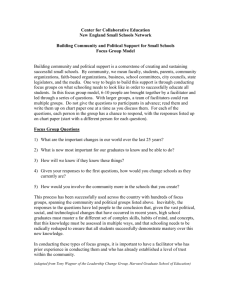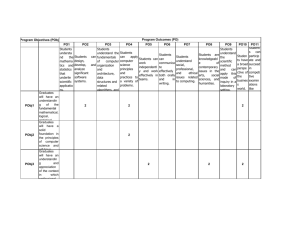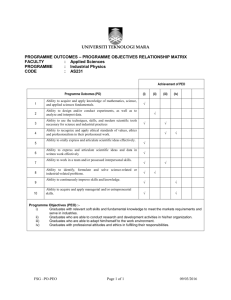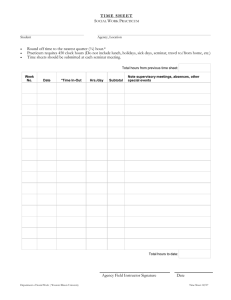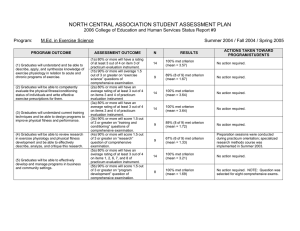Dr. J. N. Eastmond Jr. Ins. T. Department Revised 9 May 2000
advertisement
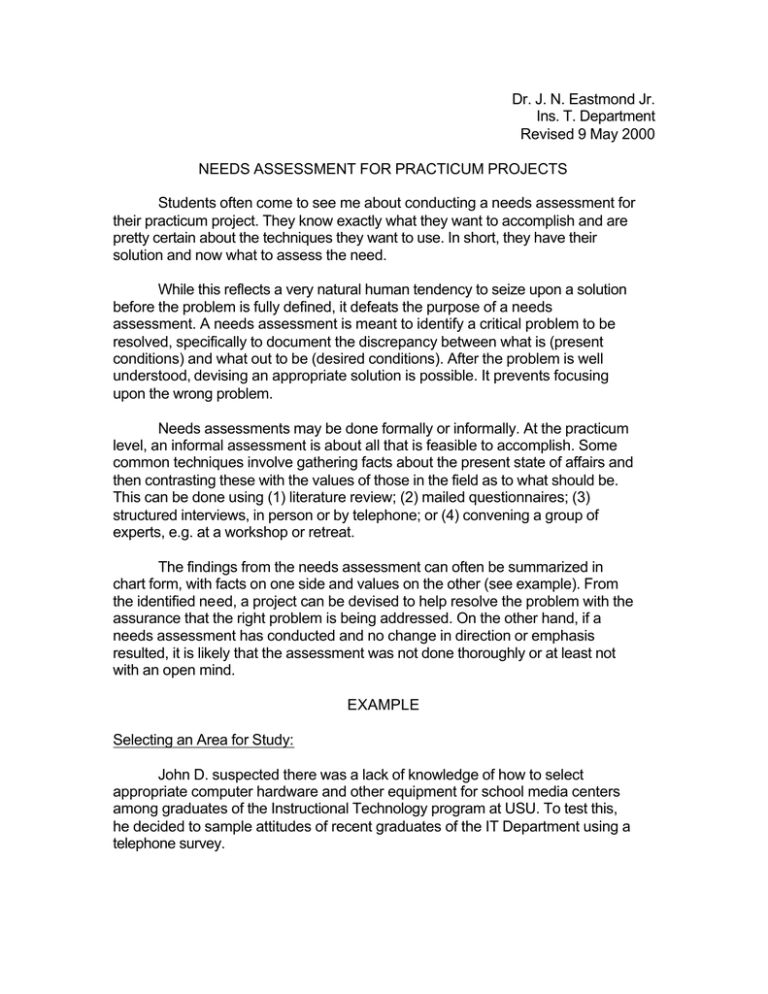
Dr. J. N. Eastmond Jr. Ins. T. Department Revised 9 May 2000 NEEDS ASSESSMENT FOR PRACTICUM PROJECTS Students often come to see me about conducting a needs assessment for their practicum project. They know exactly what they want to accomplish and are pretty certain about the techniques they want to use. In short, they have their solution and now what to assess the need. While this reflects a very natural human tendency to seize upon a solution before the problem is fully defined, it defeats the purpose of a needs assessment. A needs assessment is meant to identify a critical problem to be resolved, specifically to document the discrepancy between what is (present conditions) and what out to be (desired conditions). After the problem is well understood, devising an appropriate solution is possible. It prevents focusing upon the wrong problem. Needs assessments may be done formally or informally. At the practicum level, an informal assessment is about all that is feasible to accomplish. Some common techniques involve gathering facts about the present state of affairs and then contrasting these with the values of those in the field as to what should be. This can be done using (1) literature review; (2) mailed questionnaires; (3) structured interviews, in person or by telephone; or (4) convening a group of experts, e.g. at a workshop or retreat. The findings from the needs assessment can often be summarized in chart form, with facts on one side and values on the other (see example). From the identified need, a project can be devised to help resolve the problem with the assurance that the right problem is being addressed. On the other hand, if a needs assessment has conducted and no change in direction or emphasis resulted, it is likely that the assessment was not done thoroughly or at least not with an open mind. EXAMPLE Selecting an Area for Study: John D. suspected there was a lack of knowledge of how to select appropriate computer hardware and other equipment for school media centers among graduates of the Instructional Technology program at USU. To test this, he decided to sample attitudes of recent graduates of the IT Department using a telephone survey. 2 Conducting the Survey: To minimize telephone costs, John selected ten graduates from the previous year’s class who had located jobs in the Intermountain West. After explaining his purpose over the phone, the interview consisted of five basic questions which the respondents were asked to elaborate upon: (1) Have you had to purchase or recommend purchase of any computer hardware or any other equipment on your job? (2) did you feel that you had sufficient information to make the choice? (3) did you feel that any particular courses in your program helped you to make your selection? Which ones, if any, were most helpful? (4) what additional preparation in equipment selection do you feel should be provided in the department? (5) what means of staying up to date on new equipment do you rely upon? Supporting the Findings: Following each interview, John wrote down the important points from the conversation. There were the raw data he summarized in chart form as follows: Table 1: Summary of Needs Assessment Findings (Hypothetical) Facts Values 1. Eight out of ten (80%) of the graduates purchased equipment during their first year on the job. 1. Graduates of the department should have sufficient information—or be able to obtain information—to feel reasonably secure in making equipment purchases. 2. Six (60%) felt they had insufficient information to do so. 2. Equipment purchased should be both appropriate and dependable for school use. 3. Money for equipment purchase should not be wasted. 3. Three Ins.T. classes were cited as being helpful in making equipment selection. 4. Two graduates cited pieces of equipment which they had bought but later regretted. 5. Money available for equipment purchase is scarce in schools at present (source: State Budget Survey.) NOTE: These values are gleaned from the telephone interviews. 3 Result: From the survey, it was apparent that a critical need exists. While conducting the survey, John found three possible solutions, two of which he had not considered previously. (1) insert one or more units into existing courses; (2) develop a new course; (3) develop a handbook, like a consumer report, which could be used for reference. John chose the first option and went ahead with developing two units for a practicum. This was not very different from his original idea, but his method of structuring the units was quite different and drew heavily on suggestions he had drawn from his needs assessment.
